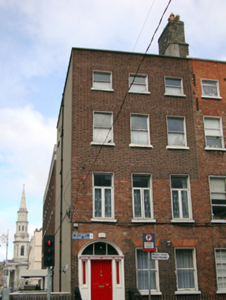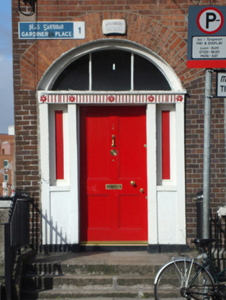Survey Data
Reg No
50010873
Rating
Regional
Categories of Special Interest
Architectural, Artistic
Original Use
House
In Use As
Apartment/flat (converted)
Date
1780 - 1800
Coordinates
315840, 235360
Date Recorded
10/10/2011
Date Updated
--/--/--
Description
End-of-terrace three-bay four-storey house over exposed basement, one of pair built c.1790. Now in multiple occupancy. M-profile pitched roof hipped to west behind parapet wall with cast-iron downpipe on west elevation breaking through granite-capped parapet. Two exposed brick chimneystacks with terracotta pots shared on party wall with No. 2 to east. Red brick wall to south elevation laid in Flemish bond, rebuilt above first floor level, to masonry plinth above rendered basement wall. Ruled-and-lined rendered wall to west (side) and north (rear) elevations, with bow end to rear elevation. Gauged brick square-headed window openings with painted patent reveals and painted granite sills throughout, having replacement one-over-one pane timber sliding sash windows throughout, excepting T-profile timber windows to first floor. Gauged brick round-headed door opening with painted stone pilasters supporting lintel cornice with fluting and paterae having tripartite fanlight and obscured glass side-lights, flanking replacement timber panelled door. Granite platform with two cast-iron bootscrapers and two granite steps bridging basement flanked by replacement railings on granite plinth wall returning to east enclose basement area, and curving round corner to west. Concrete paved path with granite kerbing and plain coal hole cover inset in granite slab.
Appraisal
No. 1 is one of a pair of similar houses, slightly reduced in scale, that terminates this fine south-facing terrace. The full-height bow to the rear, the wide doorcase and the drop in parapet level at No. 2, adds interest and variety to the terrace. The retention of its doorcase and of timber sash windows contribute to its architectural heritage quality, and the stone plinth and steps and railings to the front and side provide an appropriate setting for this Georgian townhhouse. Gardiner Place was developed by Luke Gardiner II, in c.1790, as an extension of Gardiner's Row in order to link Rutland Square (Parnell Square) with the new and fashionable Mountjoy Square. Gardiner's legacy also included the laying out of Gardiner Row (1773), Mountjoy Square (1790), Gardiner Street (1792) and many other streets surrounding Mountjoy Square. Although built as a residential street, Gardiner Place was largely inhabited by legal professionals and doctors in the mid-nineteenth century, and as tenements, social housing and as a guest house in the twentieth century.

















